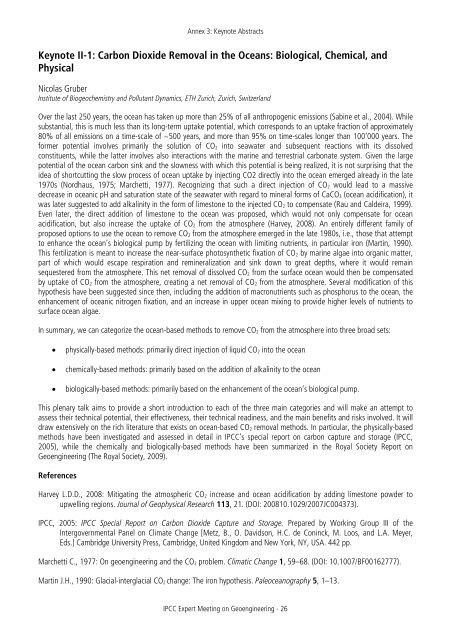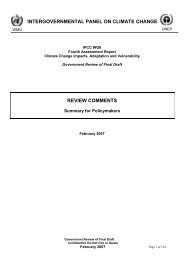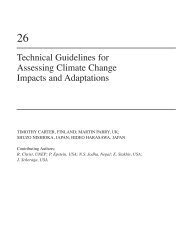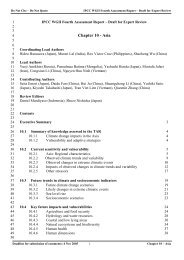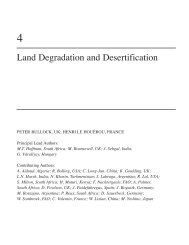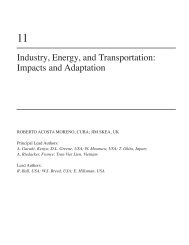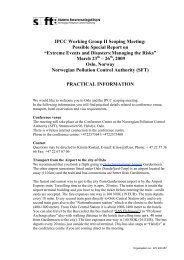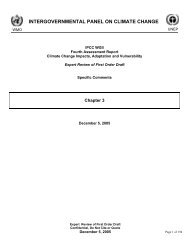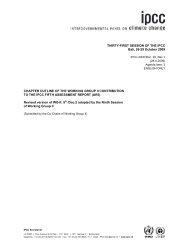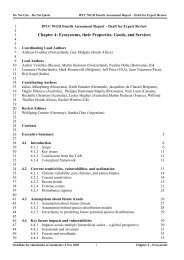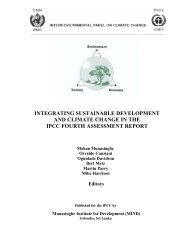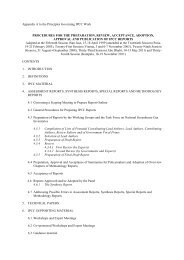IPCC Expert Meeting on Geoengineering
IPCC Expert Meeting on Geoengineering
IPCC Expert Meeting on Geoengineering
Create successful ePaper yourself
Turn your PDF publications into a flip-book with our unique Google optimized e-Paper software.
Annex 3: Keynote Abstracts<br />
Keynote II-1: Carb<strong>on</strong> Dioxide Removal in the Oceans: Biological, Chemical, and<br />
Physical<br />
Nicolas Gruber<br />
Institute of Biogeochemistry and Pollutant Dynamics, ETH Zurich, Zurich, Switzerland<br />
Over the last 250 years, the ocean has taken up more than 25% of all anthropogenic emissi<strong>on</strong>s (Sabine et al., 2004). While<br />
substantial, this is much less than its l<strong>on</strong>g-term uptake potential, which corresp<strong>on</strong>ds to an uptake fracti<strong>on</strong> of approximately<br />
80% of all emissi<strong>on</strong>s <strong>on</strong> a time-scale of ~500 years, and more than 95% <strong>on</strong> time-scales l<strong>on</strong>ger than 100’000 years. The<br />
former potential involves primarily the soluti<strong>on</strong> of CO 2 into seawater and subsequent reacti<strong>on</strong>s with its dissolved<br />
c<strong>on</strong>stituents, while the latter involves also interacti<strong>on</strong>s with the marine and terrestrial carb<strong>on</strong>ate system. Given the large<br />
potential of the ocean carb<strong>on</strong> sink and the slowness with which this potential is being realized, it is not surprising that the<br />
idea of shortcutting the slow process of ocean uptake by injecting CO2 directly into the ocean emerged already in the late<br />
1970s (Nordhaus, 1975; Marchetti, 1977). Recognizing that such a direct injecti<strong>on</strong> of CO 2 would lead to a massive<br />
decrease in oceanic pH and saturati<strong>on</strong> state of the seawater with regard to mineral forms of CaCO 3 (ocean acidificati<strong>on</strong>), it<br />
was later suggested to add alkalinity in the form of limest<strong>on</strong>e to the injected CO 2 to compensate (Rau and Caldeira, 1999).<br />
Even later, the direct additi<strong>on</strong> of limest<strong>on</strong>e to the ocean was proposed, which would not <strong>on</strong>ly compensate for ocean<br />
acidificati<strong>on</strong>, but also increase the uptake of CO 2 from the atmosphere (Harvey, 2008). An entirely different family of<br />
proposed opti<strong>on</strong>s to use the ocean to remove CO 2 from the atmosphere emerged in the late 1980s, i.e., those that attempt<br />
to enhance the ocean’s biological pump by fertilizing the ocean with limiting nutrients, in particular ir<strong>on</strong> (Martin, 1990).<br />
This fertilizati<strong>on</strong> is meant to increase the near-surface photosynthetic fixati<strong>on</strong> of CO 2 by marine algae into organic matter,<br />
part of which would escape respirati<strong>on</strong> and remineralizati<strong>on</strong> and sink down to great depths, where it would remain<br />
sequestered from the atmosphere. This net removal of dissolved CO 2 from the surface ocean would then be compensated<br />
by uptake of CO 2 from the atmosphere, creating a net removal of CO 2 from the atmosphere. Several modificati<strong>on</strong> of this<br />
hypothesis have been suggested since then, including the additi<strong>on</strong> of macr<strong>on</strong>utrients such as phosphorus to the ocean, the<br />
enhancement of oceanic nitrogen fixati<strong>on</strong>, and an increase in upper ocean mixing to provide higher levels of nutrients to<br />
surface ocean algae.<br />
In summary, we can categorize the ocean-based methods to remove CO 2 from the atmosphere into three broad sets:<br />
<br />
<br />
<br />
physically-based methods: primarily direct injecti<strong>on</strong> of liquid CO 2 into the ocean<br />
chemically-based methods: primarily based <strong>on</strong> the additi<strong>on</strong> of alkalinity to the ocean<br />
biologically-based methods: primarily based <strong>on</strong> the enhancement of the ocean’s biological pump.<br />
This plenary talk aims to provide a short introducti<strong>on</strong> to each of the three main categories and will make an attempt to<br />
assess their technical potential, their effectiveness, their technical readiness, and the main benefits and risks involved. It will<br />
draw extensively <strong>on</strong> the rich literature that exists <strong>on</strong> ocean-based CO 2 removal methods. In particular, the physically-based<br />
methods have been investigated and assessed in detail in <str<strong>on</strong>g>IPCC</str<strong>on</strong>g>’s special report <strong>on</strong> carb<strong>on</strong> capture and storage (<str<strong>on</strong>g>IPCC</str<strong>on</strong>g>,<br />
2005), while the chemically and biologically-based methods have been summarized in the Royal Society Report <strong>on</strong><br />
<strong>Geoengineering</strong> (The Royal Society, 2009).<br />
References<br />
Harvey L.D.D., 2008: Mitigating the atmospheric CO 2 increase and ocean acidificati<strong>on</strong> by adding limest<strong>on</strong>e powder to<br />
upwelling regi<strong>on</strong>s. Journal of Geophysical Research 113, 21. (DOI: 200810.1029/2007JC004373).<br />
<str<strong>on</strong>g>IPCC</str<strong>on</strong>g>, 2005: <str<strong>on</strong>g>IPCC</str<strong>on</strong>g> Special Report <strong>on</strong> Carb<strong>on</strong> Dioxide Capture and Storage. Prepared by Working Group III of the<br />
Intergovernmental Panel <strong>on</strong> Climate Change [Metz, B., O. Davids<strong>on</strong>, H.C. de C<strong>on</strong>inck, M. Loos, and L.A. Meyer,<br />
Eds.] Cambridge University Press, Cambridge, United Kingdom and New York, NY, USA. 442 pp.<br />
Marchetti C., 1977: On geoengineering and the CO 2 problem. Climatic Change 1, 59–68. (DOI: 10.1007/BF00162777).<br />
Martin J.H., 1990: Glacial-interglacial CO 2 change: The ir<strong>on</strong> hypothesis. Paleoceanography 5, 1–13.<br />
<str<strong>on</strong>g>IPCC</str<strong>on</strong>g> <str<strong>on</strong>g>Expert</str<strong>on</strong>g> <str<strong>on</strong>g>Meeting</str<strong>on</strong>g> <strong>on</strong> <strong>Geoengineering</strong> - 26


